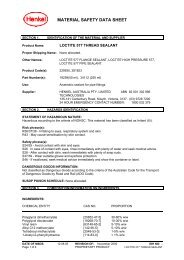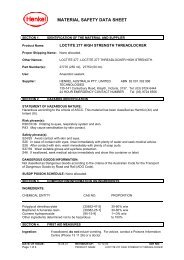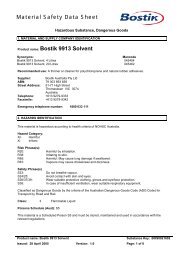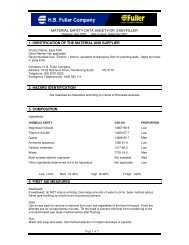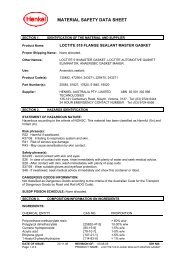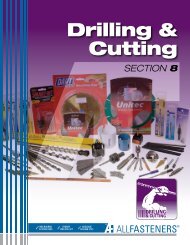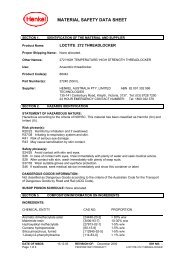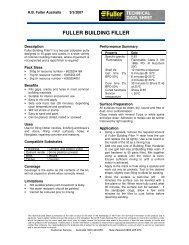Plumbweld PVC Cement N Blue - All Fasteners
Plumbweld PVC Cement N Blue - All Fasteners
Plumbweld PVC Cement N Blue - All Fasteners
You also want an ePaper? Increase the reach of your titles
YUMPU automatically turns print PDFs into web optimized ePapers that Google loves.
Material Safety Data SheetThis is not a controlled document. To obtain the most recent MSDS please go to www.bostik.com.auHazardous Substance, Dangerous Goods1. MATERIAL AND SUPPLY COMPANY IDENTIFICATIONProduct name: <strong>Plumbweld</strong> <strong>PVC</strong> <strong>Cement</strong> N <strong>Blue</strong>Synonyms:Mancode<strong>Plumbweld</strong> <strong>PVC</strong> <strong>Cement</strong> N <strong>Blue</strong>, 125 mL 078328<strong>Plumbweld</strong> <strong>PVC</strong> <strong>Cement</strong> N <strong>Blue</strong>, 250 mL 078336<strong>Plumbweld</strong> <strong>PVC</strong> <strong>Cement</strong> N <strong>Blue</strong>, 500 mL 078344<strong>Plumbweld</strong> <strong>PVC</strong> <strong>Cement</strong> N <strong>Blue</strong>, 1 Litre 078352<strong>Plumbweld</strong> <strong>PVC</strong> <strong>Cement</strong> N <strong>Blue</strong>, 4 Litres 078360Recommended use: Solvent welding cement for u<strong>PVC</strong> plasticsSupplier: Bostik Australia Pty LtdABN: 79 003 893 838Street Address: 51-71 High StreetThomastown VIC 3074AustraliaTelephone: +613 9279-9333Facsimile: +613 9279-9342Emergency telephone number: 1800 033 1112. HAZARDS IDENTIFICATIONBased on available information, this material is not classified as hazardous according to criteria of ASCCAustralia.Hazard Category:Xn HarmfulXi IrritantRisk Phrase(s):R20: Harmful by inhalation.R36/37:Irritating to eyes and respiratory system.R66: Repeated exposure may cause skin dryness or cracking.R67: Vapours may cause drowsiness and dizziness.Safety Phrase(s):S23: Do not breathe vapour.S24/25:Avoid contact with skin and eyes.S36/37/39: Wear suitable protective clothing, gloves and eye/face protection.S38: In case of insufficient ventilation, wear suitable respiratory equipment.Classified as Dangerous Goods by the criteria of the Australian Dangerous Goods Code (ADG Code) forTransport by Road and Rail.Class: 3 Flammable LiquidPoisons Schedule (Aust): S5Product name: <strong>Plumbweld</strong> <strong>PVC</strong> <strong>Cement</strong> N <strong>Blue</strong>Issued: 11 November 2008 Version: 2.0 Page: 1 of 9Substance Key: BOS0105102
Material Safety Data SheetThis is not a controlled document. To obtain the most recent MSDS please go to www.bostik.com.auThis material is a Scheduled Poison S5 and must be stored, maintained and used in accordance with therelevant regulations.3. COMPOSITION INFORMATIONCHEMICAL ENTITY CAS NO. PROPORTIONMethyl ethyl ketone 78-93-3 30-60%Cyclohexanone 108-94-1 10-30%Acetone 67-64-1 10-30%Ingredients determined to be non-hazardous - Balance________100%4. FIRST AID MEASURESIf poisoning occurs, contact a doctor or Poisons Information Centre (Phone Australia 131 126, New Zealand0800 764 766).Inhalation: Remove victim from exposure - avoid becoming a casualty. Remove contaminated clothing andloosen remaining clothing. <strong>All</strong>ow patient to assume most comfortable position and keep warm. Keep at restuntil fully recovered. If breathing laboured and patient cyanotic (blue), ensure airways are clear and have aqualified person give oxygen through a facemask. If breathing has stopped apply artificial respiration atonce. In the event of cardiac arrest, apply external cardiac massage. Seek immediate medical advice.Skin contact: For gross contamination, immediately drench with water and remove clothing. Continue toflush skin and hair with plenty of water (and soap if material is insoluble). For skin burns, cover with a clean,dry dressing until medical help is available. If blistering occurs, do NOT break blisters. If swelling, redness,blistering, or irritation occurs seek medical assistance.Eye contact: If in eyes, hold eyelids apart and flush the eyes continuously with running water. Continueflushing until advised to stop by the Poisons Information Centre or a Doctor; or for at least 15 minutes andtransport to Doctor or Hospital.Ingestion: Rinse mouth with water. If swallowed, do NOT induce vomiting. Give a glass of water to drink.Never give anything by the mouth to an unconscious patient. If vomiting occurs give further water. Seekmedical advice.Notes to physician: Treat symptomatically.5. FIRE-FIGHTING MEASURESSpecific hazards: Flammable liquid. May form flammable vapour mixtures with air. Flameproof equipmentnecessary in area where this chemical is being used. Nearby equipment must be earthed. Electricalrequirements for work area should be assessed according to AS3000. Vapour may travel a considerabledistance to source of ignition and flash back. Avoid all ignition sources. <strong>All</strong> potential sources of ignition(open flames, pilot lights, furnaces, spark producing switches and electrical equipment etc) must beeliminated both in and near the work area. Do NOT smoke.Product name: <strong>Plumbweld</strong> <strong>PVC</strong> <strong>Cement</strong> N <strong>Blue</strong>Issued: 11 November 2008 Version: 2.0 Page: 2 of 9Substance Key: BOS0105102
Material Safety Data SheetThis is not a controlled document. To obtain the most recent MSDS please go to www.bostik.com.auFire fighting further advice: If safe to do so, remove containers from path of fire. Keep containers coolwith water spray. On burning may emit toxic fumes. Fire fighters to wear self-contained breathingapparatus and suitable protective clothing if risk of exposure to vapour or products of combustion.Hazchem Code: 3[Y]E.Suitable extinguishing media: If material is involved in a fire use foam, dry agent (carbon dioxide, drychemical powder).6. ACCIDENTAL RELEASE MEASURESSMALL SPILLSWear protective equipment to prevent skin and eye contamination. Avoid inhalation of vapours. Wipe upwith absorbent (clean rag or paper towels). Collect and seal in properly labelled containers or drums fordisposal.LARGE SPILLSShut off all possible sources of ignition. Clear area of all unprotected personnel. Slippery when spilt. Avoidaccidents, clean up immediately. Wear protective equipment to prevent skin and eye contamination and theinhalation of vapours. Work up wind or increase ventilation. Contain - prevent run off into drains andwaterways. Use absorbent (soil, sand or other inert material). Use a spark-free shovel. Collect and seal inproperly labelled containers or drums for disposal. If contamination of sewers or waterways has occurredadvise local emergency services.Dangerous Goods – Initial Emergency Response Guide No: 147. HANDLING AND STORAGEHandling: Avoid skin and eye contact and inhalation of vapour, mist or aerosols.Storage: Store in a cool, dry, well-ventilated place and out of direct sunlight. Store away from incompatiblematerials described in Section 10. Store away from sources of heat or ignition. Keep containers closedwhen not in use - check regularly for leaks.This material is classified as a Dangerous Good Class 3 Flammable Liquid as per the criteria of theAustralian Dangerous Goods Code and must be stored in accordance with the relevant regulations.This material is a Scheduled Poison S5 and must be stored, maintained and used in accordance with therelevant regulations.8. EXPOSURE CONTROLS / PERSONAL PROTECTIONNational occupational exposure limits:No value assigned for this specific material by the National Occupational Health and Safety Commission(NOHSC Australia).Product name: <strong>Plumbweld</strong> <strong>PVC</strong> <strong>Cement</strong> N <strong>Blue</strong>Issued: 11 November 2008 Version: 2.0 Page: 3 of 9Substance Key: BOS0105102
Material Safety Data SheetThis is not a controlled document. To obtain the most recent MSDS please go to www.bostik.com.auHowever for:TWA STEL CARCINOGEN NOTICESppm mg/m3 ppm mg/m3 CATEGORYMethyl ethyl ketone 150 445 300 890 - -Cyclohexanone 25 100 - - - SkAcetone 500 1,185 1,000 2,375 - -As published by the Australian Safety and Compensation Council (ASCC).TWA - The time-weighted average airborne concentration over an eight-hour working day, for a five-dayworking week over an entire working life.STEL (Short Term Exposure Limit) - the average airborne concentration over a 15 minute period whichshould not be exceeded at any time during a normal eight-hour workday.`Sk' Notice - absorption through the skin may be a significant source of exposure. The exposure standard isinvalidated if such contact should occur.These Exposure Standards are guides to be used in the control of occupational health hazards. <strong>All</strong>atmospheric contamination should be kept too as low a level as is workable. These exposure standardsshould not be used as fine dividing lines between safe and dangerous concentrations of chemicals. Theyare not a measure of relative toxicity.If the directions for use on the product label are followed, exposure of individuals using the product shouldnot exceed the above standard. The standard was created for workers who are routinely, potentiallyexposed during product manufacture.Biological Limit Values: As per the “National Model Regulations for the Control of Workplace HazardousSubstances (ASCC)” the ingredients in this material do not have a Biological Limit <strong>All</strong>ocated.Engineering measures: Ensure ventilation is adequate to maintain air concentrations below ExposureStandards. Use with local exhaust ventilation or while wearing appropriate respirator. Vapour heavier thanair - prevent concentration in hollows or sumps. DO NOT enter confined spaces where vapour may havecollected. Keep containers closed when not in use.Personal protection equipment: OVERALLS, SAFETY SHOES, CHEMICAL GOGGLES, GLOVES,RESPIRATOR.Wear overalls, chemical goggles and impervious gloves. Use with adequate ventilation. If inhalation riskexists wear organic vapour/particulate respirator meeting the requirements of AS/NZS 1715 and AS/NZS1716. Available information suggests that gloves made from nitrile rubber should be suitable for intermittentcontact. However, due to variations in glove construction and local conditions, the user should make a finalassessment. Always wash hands before smoking, eating, drinking or using the toilet. Wash contaminatedclothing and other protective equipment before storing or re-using.9. PHYSICAL AND CHEMICAL PROPERTIESForm / Colour / Odour: Medium bodied blue liquid with ketonic odourSolubility:Insoluble in waterSpecific Gravity (20 °C): Approx 0.94Product name: <strong>Plumbweld</strong> <strong>PVC</strong> <strong>Cement</strong> N <strong>Blue</strong>Issued: 11 November 2008 Version: 2.0 Page: 4 of 9Substance Key: BOS0105102
Material Safety Data SheetThis is not a controlled document. To obtain the most recent MSDS please go to www.bostik.com.auRelative Vapour Density (air=1): >1Vapour Pressure (20 °C):9,500 Pa*Flash Point (°C): -4*Flammability Limits (%): LEL – 1.8; UEL – 11.5*Autoignition Temperature (°C): 515*Melting Point/Range (°C):N AvBoiling Point/Range (°C):N AvpH:N AppTotal VOC (g/Litre): 508* values for methyl ethyl ketone(Typical values only - consult specification sheet)N Av = Not available N App = Not applicable10. STABILITY AND REACTIVITYChemical stability: This material is thermally stable when stored and used as directed.Conditions to avoid: Elevated temperatures and sources of ignition.Incompatible Materials: Oxidising agents.Hazardous decomposition products: Oxides of carbon and nitrogen, smoke and other toxic fumes.Hazardous reactions: No known hazardous reactions.11. TOXICOLOGICAL INFORMATIONNo adverse health effects expected if the product is handled in accordance with this Safety Data Sheet andthe product label. Symptoms or effects that may arise if the product is mishandled and overexposure occursare:Acute EffectsInhalation: Harmful by inhalation. Material may be irritant to mucous membranes and respiratory tract.Inhalation of vapour can result in headaches, dizziness and possible nausea. Inhalation of highconcentrations can produce central nervous system depression, which can lead to loss of co-ordination,impaired judgement and if exposure is prolonged, unconsciousness.Skin contact: Contact with skin may result in irritation. Will have a degreasing action on the skin.Repeated or prolonged skin contact may lead to irritant contact dermatitis.Eye contact: An eye irritant.Ingestion: Swallowing can result in nausea, vomiting and irritation of the gastrointestinal tract.Long Term Effects: No information available for product.Acute toxicity / Chronic toxicityNo LD50 data available for the product. However, for the constituent:Product name: <strong>Plumbweld</strong> <strong>PVC</strong> <strong>Cement</strong> N <strong>Blue</strong>Issued: 11 November 2008 Version: 2.0 Page: 5 of 9Substance Key: BOS0105102
Material Safety Data SheetThis is not a controlled document. To obtain the most recent MSDS please go to www.bostik.com.auMethyl ethyl ketoneOral LD50 (rat):Inhalation LC50 (rat):Dermal LD50 Range (rabbit):EYES (rabbit):2,737 mg/kg23,500 mg/m3/8 hr5,000-13,000 mg/kgModerate irritant. Eye irritation reported in humans exposed to vapour at350 ppmMUTAGENICITY: Methyl ethyl ketone has been shown to be without genotoxic activity in a variety of invitro and in vivo tests. Among the tests, which produced negative results, are assays for point mutation(eg. Ames test and mouse lymphoma), chromosomal aberration (rat liver cells in vitro and mouse bonemarrow in vivo), DNA damage (unscheduled DNA synthesis in rat hepatocytes), and morphologictransformation (BALB 3T3 morphologic transformation.REPRODUCTIVE/DEVELOPMENTAL EFFECTS: No human studies have been reported. An initialinhalation study with rats indicated fetotoxicity (eg. delayed foetal development) and possibleteratogenicity at 3000 ppm. However, a comprehensive follow-up study in rats showed only slightfetotoxicity accompanied by maternal toxicity at 3000 ppm, but no teratogenic effects. No significantdifferences were seen between rats exposed to 1000 ppm or 400 ppm methyl ethyl ketone and thecontrol. Likewise, an inhalation study with mice showed only fetotoxicity at 3000 ppm and no effects at1000 ppm or 400 ppm methyl ethyl ketone.Methyl ethyl ketone is not neurotoxic. It has been shown to potentiate the neurotoxic effects of hexane,2,5-hexanedione and methyl-n-butyl ketone and has also potentiated the liver toxicity of halogenatedsolvents (eg. chloroform and carbon tetrachloride) in animal studies.Not a skin sensitiser based on human patch test.CyclohexanoneOral LD50(rat): 1,400-2100 mg/kgInhalation LC50(rat): 8,000 ppm/4 hrSKIN (rabbit):EYES (rabbit):Mild irritantSevere irritantRabbits exposed to 190 ppm of cyclohexanone for 50 days, 6 hour/days showed barely demonstrabledegenerative changes in the liver and kidneys.Positive in IN VITRO mutagenicity assays.In sensory threshold tests involving human subjects exposure at 25 ppm was not uncomfortable for mostsubjects; 50 ppm was irritating, especially to the throat; exposure at 75 ppm for 3-5 minutes resulted inmore pronounced irritation of the eyes, nose and throat.12. ECOLOGICAL INFORMATIONAvoid contaminating waterways. No data available for the product. However, for the constituent:Ecotoxicity: No information available.Persistence and degradability: No information available.Mobility: No information available.Product name: <strong>Plumbweld</strong> <strong>PVC</strong> <strong>Cement</strong> N <strong>Blue</strong>Substance Key: BOS0105102Issued: 11 November 2008 Version: 2.0 Page: 6 of 9
Material Safety Data SheetThis is not a controlled document. To obtain the most recent MSDS please go to www.bostik.com.au13. DISPOSAL CONSIDERATIONSRefer to State/Territory Land Waste Management Authority.14. TRANSPORT INFORMATIONROAD AND RAIL TRANSPORTClassified as Dangerous Goods by the criteria of the Australian Dangerous Goods Code (ADG Code) forTransport by Road and Rail.UN No: 1133Dangerous Goods Class: 3Packing Group:IIHazchem Code:3[Y]EEmergency Response Guide No: 14Proper Shipping Name: ADHESIVE containing flammable liquidsSegregation Dangerous Goods: Not to be loaded with explosives (Class 1), flammable gases (Class 2.1),if both are in bulk, toxic gases (Class 2.3), spontaneously combustible substances (Class 4.2), oxidisingagents (Class 5.1), organic peroxides (Class 5.2) or radioactive substances (Class 7), however exemptionsmay apply.MARINE TRANSPORTClassified as Dangerous Goods by the criteria of the International Maritime Dangerous Goods Code (IMDGCode) for transport by sea.UN No: 1133Dangerous Goods Class: 3Packing Group:IIProper Shipping Name: ADHESIVE containing flammable liquidsAIR TRANSPORTClassified as Dangerous Goods by the criteria of the International Air Transport Association (IATA)Dangerous Goods Regulations for transport by air.UN No: 1133Dangerous Goods Class: 3Packing Group:IIProper Shipping Name: ADHESIVE containing flammable liquids15. REGULATORY INFORMATIONPoisons Schedule (Aust): S5<strong>All</strong> the constituents of this material are listed on the Australian Inventory of Chemical Substances (AICS).Product name: <strong>Plumbweld</strong> <strong>PVC</strong> <strong>Cement</strong> N <strong>Blue</strong>Issued: 11 November 2008 Version: 2.0 Page: 7 of 9Substance Key: BOS0105102
Material Safety Data SheetThis is not a controlled document. To obtain the most recent MSDS please go to www.bostik.com.au16. OTHER INFORMATIONLiterary referenceThis Material Safety Data Sheet has been prepared by EIAS Pty Ltd on behalf of its client.Reason(s) For Issue: Change to product formulationMaterial Safety Data Sheets are updated frequently. Please ensure that you have a current copy.Product name: <strong>Plumbweld</strong> <strong>PVC</strong> <strong>Cement</strong> N <strong>Blue</strong>Issued: 11 November 2008 Version: 2.0 Page: 8 of 9Substance Key: BOS0105102
Material Safety Data SheetThis is not a controlled document. To obtain the most recent MSDS please go to www.bostik.com.auThis MSDS summarises at the date of issue our best knowledge of the health and safety hazard informationof the product, and in particular how to safely handle and use the product in the workplace. Since BostikAustralia Pty Ltd cannot anticipate or control the conditions under which the product may be used, each usermust, prior to usage, review this MSDS in the context of how the user intends to handle and use the productin the workplace.If clarification or further information is needed to ensure that an appropriate assessment can be made, theuser should contact this company.Our responsibility for product as sold is subject to our standard terms and conditions, a copy of which is sentto our customers and is also available upon request.Product name: <strong>Plumbweld</strong> <strong>PVC</strong> <strong>Cement</strong> N <strong>Blue</strong>Issued: 11 November 2008 Version: 2.0 Page: 9 of 9Substance Key: BOS0105102



